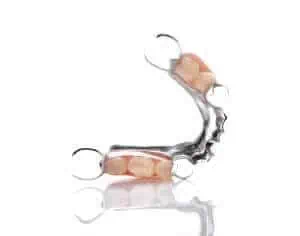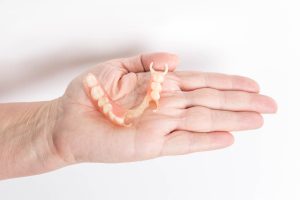Are you missing teeth and interested in replacing them with a Valplast partial denture? These dentures are the most well-known and popular flexible dentures available, but are they the right option for you?
No matter how well your dentures fit at first, they may not stay that way because your face and jaw are liable to change shape over time. Flexible dentures like Valplast, on the other hand, are flexible and can adapt and change shape with your mouth.
This article will go in-depth and discuss everything you need to know about them, including:
- What is a Valplast denture?
- How much do they cost?
- Valplast dentures disadvantages and advantages
- What do Valplast reviews say?
Let’s jump right in so you can get those missing teeth replaced!
What is a Valplast denture?
Valplast is a brand of removable flexible partial dentures. They are made from a nylon resin that is not only durable but is also flexible enough to move and adapt with your mouth.
This makes them a lot more comfortable to wear than dentures that are made from hard unmoving acrylic. However, it does mean that you cannot get Valplast full dentures, as full mouth dentures require some rigidity to stay in place.
Unlike other types of partial dentures, they don’t have uncomfortable metal clasps to keep them in place that can be visible at times. Instead, they have little projections made from the same nylon resin material that fits over the teeth and gums to help the denture stay in place.
Valplast dentures match your natural teeth and gums better than traditional dentures, although they may be prone to discoloration over time.
Overall, Valplast dentures could be a better choice for you if you are looking to replace one or more teeth. They are strong, lightweight, and blend in well with your remaining natural teeth, aesthetically speaking.


What is the process for getting a Valpast denture?
If you are interested in getting a Valplast partial denture the process is simple. The first step is to search for ‘Valplast dentist near me’ or ‘Valplast dentures near me’.
Then, book a consultation so the dentist can evaluate your teeth and mouth to see if they would be right for you. Once a decision has been made, your denture will be custom-made for you without any changes to your natural teeth.
How much does a Valplast denture cost?
Valplast dentures cost anywhere from $700 to $2,000 per arch, but every practice is different and prices can range between dentists and between states and cities.
The cost of a Valplast denture is more affordable than some of the other ways to replace missing teeth. However, due to the materials used they are more expensive than traditional dentures.
Advantages and disadvantages of a Valplast denture
While Valplast flexible dentures have their advantages over traditional dentures and more expensive procedures like dental implants and crowns, they have their disadvantages as well.


Advantages
- The thinner lightweight flexible material is more comfortable to wear
- Blend in well with your natural teeth and gums
- The flexible material moves with your mouth and adapts to your mouth as it changes shape over time
- Less likely to stain
- Non-allergenic, monomer and formaldehyde-free
- Good for those with limited mouth opening
Disadvantages
- They are not permanent, and therefore not suitable for those looking for a long-term solution
- It is not possible to get them relined if they no longer fit
- They cannot easily be repaired if they break
- May feel bulkier than other partial dentures
- Valplast dentures can take longer to create in the lab
- Might suffer color degradation with time
- Strict dental hygiene needed
What are common Valplast partial dentures problems?
Valplast partial dentures may be a preferable option to traditional partials, but they do have their problems. As mentioned above, if you break your Valpast denture it usually cannot be fixed. So be careful with it and make sure you put it in a safe place when you’re not wearing it.
It’s also not possible to get a denture reline with a Valplast denture, due to the type of material it’s made from.


If you find your partial has rough edges that are causing you irritation or even ulcers, you can get your dentures’ edges smoothed out so they are more comfortable. You may also feel slight discomfort or irritation while you are getting used to wearing your partial, and it can take longer to get used to a Valplast denture compared to traditional partials.
Discoloration over time can also be a problem as it may mean you have to get your denture replaced sooner than you think, and flexible dentures are more susceptible to scratches and damage.
Other Valplast partial dentures problems can occur from not cleaning your denture correctly every day, like bad breath, good disease, tooth decay and oral thrush. So make sure you know the right way to care for and clean your dentures and make sure you maintain strict oral hygiene to avoid issues.
Valplast dentures vs traditional dentures
As we have touched on the differences between Valplast dentures and traditional dentures quite a bit, here is a table to summarize the differences between them:
Traditional dentures | Valplast flexible dentures | |
Material | Metal and acrylic | Thermoplastic resin |
Full or partial? | Full mouth, partial and single tooth | Partial or single tooth |
Advantages |
|
|
Disadvantages |
|
|
Valplast alternatives
Valplast isn’t the only brand of flexible denture around. Have a look at the following brand comparisons to see how they hold up:
Duraflex vs Valplast
Duraflex and Valplast are both comfortable flexible dentures that require little to no tooth preparation. However, Duraflex is made from an unbreakable thermoplastic material that is better for adjusting and easier to polish.
Duraflex partial dentures are also more resistant to water, so they won’t discolor or absorb odors over the years.
The biocompatible nylon thermoplastic of Valplast is ideal for both hard and soft tissues and tends to be a bit more aesthetically pleasing than Duraflex.
Flexite vs Valplast
Flexite is another nylon-based thermoplastic flexible denture. The main difference between Flexite and Valplast dentures is that Flexite dentures can be repaired and relined, whereas Valplast is pretty much unfixable if damaged.
The good news for Valplast patients is that Valplast comes with a lifetime warranty from the manufacturer against breakage, so you can get it replaced if it does break.
Valplast denture reviews
The first review is from a dental hygienist who talks about the benefit of having a flexible partial denture over traditional types. Michelle explains how much less adjusting you need with a flexible denture, as it will custom fit itself to your mouth.
This means fewer visits with the dentist to get adjustments. Michelle also explains that flexible dentures are a lot more comfortable to wear and you don’t get as many sore spots.
The next review is from a woman that has a partial Valplast denture. She reviews her experience with her flexible dentures, and her overall opinion is that they are much more comfortable than her old regular partial denture.
Then she shows us her denture and explains that is definitely not fragile, and yet still flexible. She also shows her Valplast partial before and after clips in the video.
Valplast dentures near me
You may be wondering how to find a dentist who offers Valplast dentures near you. All you have to do to find one is call 866-383-0748. You’ll be connected with a live operator who will be able to match you with a dentist who offers Valplast in your area.
Conclusion
Valplast dentures are flexible partial dentures that are an affordable solution for missing teeth. The material that they are made from is thin, durable, and flexible and allows the denture to move and adapt to your mouth as it changes over time.
They are much more comfortable than traditional dentures, but they cannot be relined or fixed if they no longer fit, or if they break. And, although they blend in well with your natural teeth and gums, they are prone to discoloration over time.
These dentures are much more affordable than other more permanent solutions such as dental implants or crowns. But if you are still concerned about the cost, you can look into dental financing or payment plans with your dentist.
IOSR Journal of Dental and Medical Sciences: A Review: Flexible Removable Partial Dentures. Consulted 25th November 2021.
ResearchGate: Flexible Dentures in Prosthodontics -An Overview. Consulted 25th November 2021.
ResearchGate: A Study on Flexible Dentures. Consulted 11th January 2022.




